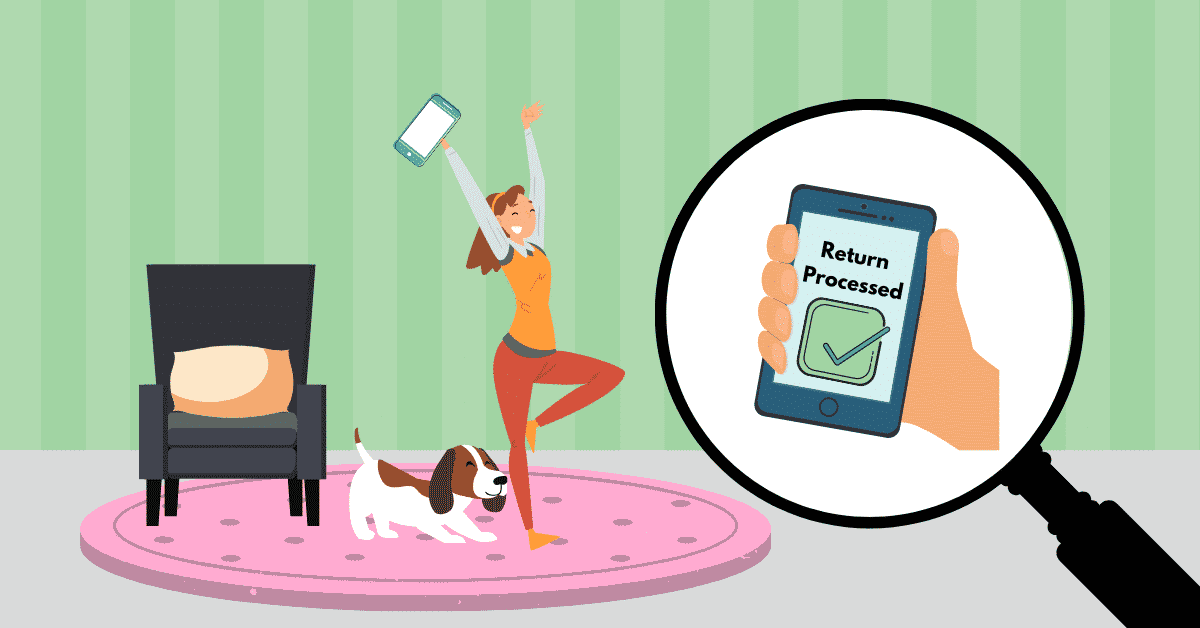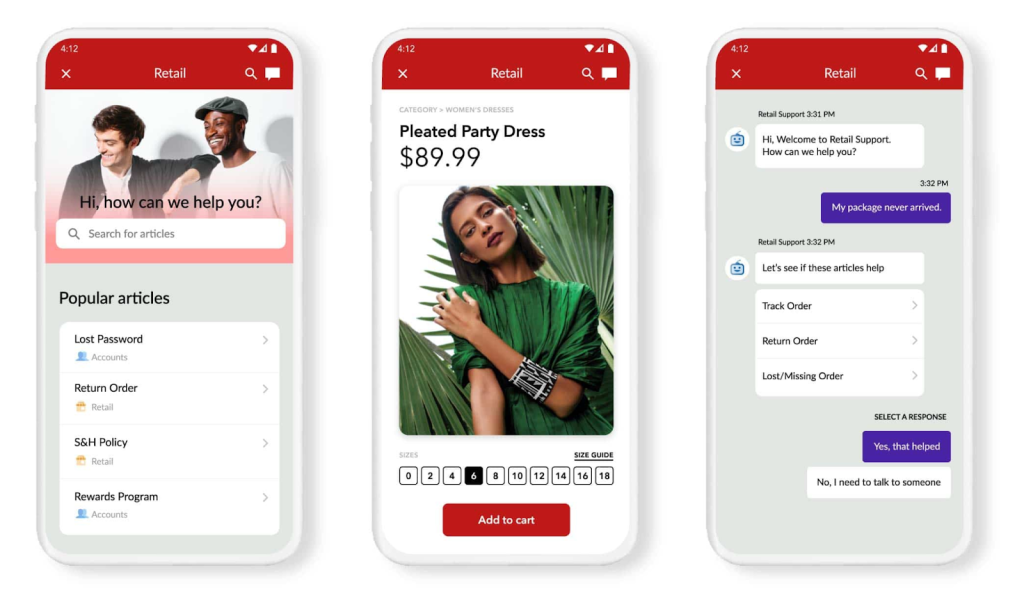In our digital-first world, we’ve become accustomed to instant gratification. For brands, this means providing solutions and answers to customers’ questions in a near-instant. Take too long and your customers won’t be happy. This is where offering customer self service can make a significant difference to your customer experience and satisfaction.
Customer self service defined
Customer self service is a support option that empowers customers to find solutions themselves, often through resources like a knowledge base, QuickSearch Bots, or training videos. Because customers resolve their inquiries on their own, there’s no need for an agent to assist them. It can free up agents to deal with more complex issues (with associated productivity gains and cost savings).
It also improves customer experience, as customers don’t have to wait on the phone or on a live chat for an available agent. In fact, 33 percent of customers express frustration with having to wait on hold when trying to resolve an issue.
Becoming the norm
Self service is growing in popularity amongst business leaders as they realize the cost, productivity and satisfaction gains to be had. 91 percent of business leaders identify self service as a priority investment focus for their brand, understanding that such a move will reduce their contact center costs, drive vital customer journey metrics and relieve pressure on their agents.
Now, over 77 percent of customers have used a customer self service resource to answer their inquiry. As more people turn to digital channels before calling a contact center, and as online support options proliferate with the Internet of Things and smart virtual assistants, this number will undoubtedly rise.
The benefits of providing self service tools
Self service is quickly becoming the preferred method for customer service for both brands and customers. It provides faster solutions that are available whenever a customer requires them.
Available 24/7
It can be difficult and expensive to staff a contact center 24/7 but with self service options like QuickSearch Bots and knowledge bases available, a customer can engage with these resources when needed. Simple questions can be answered through self service, while more complex ones can be escalated to an agent.
Improved customer satisfaction
This will have a knock-on impact on customer satisfaction as their inquiries are dealt with more quickly and efficiently. Self service offers a better overall experience compared to, say, remaining on hold for hours, and it meets the expectations of digital-native customers.
Greater scalability
Your support team’s scalability will also improve as the self service resources do much of the heavy lifting. Knowledge base content, for instance, can be translated to meet the needs of customers in different countries. Helpshift’s QuickSearch Bots can automatically detect and support multiple languages. Again, your customer support resources will be available 24/7 so time zone differences won’t have as much of an impact.
Plus, with some customers resolving their issues without an agent’s input, the pressure on your team will decrease. Particularly around peak periods where demand on the team may lead to several hours or days wait for customers without a self service option.
Better agent job satisfaction
Internally, you’ll find your contact center operations will be streamlined as simpler inquiries will be dealt with automatically without a human agent getting involved. With more time to focus on complex and challenging issues, agents will likely experience greater job satisfaction. They’ll be freed from answering endless mundane and repetitive questions – and the stress of dealing with a growing ticket backlog during busy periods will be a thing of the past. Customers with pressing and difficult issues will get immediate attention because agents aren’t busy dealing with multiple smaller problems.
Cost savings
There are cost savings to be had too. Once the resource and technology has been set up, a self service interaction will cost much less than a similar one with an agent. If demand on your contact center increases, your agent headcount may not have to rise as steeply because of the self service tools’ support.
In action: Vivino’s satisfaction and efficiency boost
Wine marketplace Vivino experienced many of these benefits by setting up a comprehensive and well-researched knowledge base. The average time that it took for an agent to respond to a ticket improved by 90 percent because the knowledge base successfully deals with 95 percent of tickets. This allowed the team to focus on providing real-time support to the remaining 5 percent of customers who need their help most. Especially the ones who were buying and selling regularly on the marketplace.
Customer satisfaction improved because of the self service resources. CSAT scores increased by 85 percent after the knowledge base’s launch and the brand’s repeat business and retention also dramatically increased.
5 ways to improve your customer self service
Customer self service is relatively easy to adopt and integrate into your existing customer service offer. That said, any self service initiative should be well-researched, with clear goals and success metrics tracked to ensure its success. These may include the number of visits to a knowledge base article, or an QuickSearch Bot’s successful deflection rate. Positive results from your self service initiative depend on how easy your content is to access, the quality of your response, and the quantity of information available.
An effective self service resource usually involves a company-wide approach, so when you’re setting it up, involve your support, sales, marketing, operations and product teams early-on in the process. These stakeholders can help you understand your customers’ common questions, pain points, and the channels they use most.
To help you get started in developing your own self service resource, we’ve listed five of the most popular ways to empower customers in helping themselves.
1. Build a knowledge base
One of the best places to start is with a knowledge base that either exists on your website or is linked to it for customers to find easily. Knowledge bases are detailed banks of free content (usually written or video) that help customers troubleshoot problems or learn more about your brand and products. They can be useful for existing customers and also prospects who might want to know more about your brand.
Now, there are a few considerations when building your knowledge base. It should always be customer focused, so a good starting point is identifying the questions that they commonly ask your support team and use this as the basis for your articles. Gather feedback about your knowledge base regularly as this will tell you if content is working well. Your knowledge base should also be easily searchable so customers can quickly find what they need, and mobile-friendly for customers to access on-the-go. Helpshift’s Mobile Help Center supports in-app self service for multiple mobile platforms and apps, while its search function can auto-populate queries based on existing content.
2. Automation
Automation can help to save time for your customers and agents. It’s expected that, by 2021, 15 percent of all customer service interactions will be completely handled by automation or artificial intelligence (AI). An increase of 400 percent since 2017. Brands that use bots to collect additional information or that fully automate certain inquiry workflows are able to achieve extremely high levels of automation without negatively impacting CSAT and regularly outperform their industry peers.
Simple automation might involve collecting relevant customer information before handing over to an agent, or letting a customer know when a contact center’s opening hours are. More complex interactions can be programmed into bots, like QuickSearch Bots or decision-tree based bots, which will interact with a customer based on their responses and decisions.
3. QuickSearch Bots
Automated QuickSearch Bots (like the ones offered by Helpshift) can drive intelligent customer recommendations based on existing content in your FAQs or knowledge base. An QuickSearch Bot can quickly answer queries within a conversation or fine-tune a help center’s search results to the customer’s needs. Providing a more targeted and conversational way of presenting your knowledge content.
Machine learning will improve recommendations with every bot interaction, improving the quality of responses. If an issue is too complex for the QuickSearch Bot to handle, it can seamlessly hand over to an agent with all the information it had previously gathered from the customer (so they don’t have to repeat themselves).
One thing to consider, however, when implementing a bot is that they can only be used in messaging channels. Email and web forms cannot efficiently leverage bots as the format or email and forms aren’t naturally conversational – unlike live chat or in-app messaging.
4. Product training videos
Videos can provide detailed explanations about how your product works, how to get the best returns from it, and how to optimize it. Some brands offer videos as part of their customer service agent training or to certify a user as a product expert. The next logical step in this is to offer such content to your customers as a self service tool. By offering training on your products, you will improve their overall experience of using the product, reduce the likelihood of them needing help, and also showcase your dedication to their success.
5. Community pages
Creating a community forum allows you to address the most common queries from your customers and also connect them with their peers. Instead of customers immediately turning to your support team, they can ask forum members for advice. Forums can also become a place to share best practices and gather direct feedback from your customers without lengthy market research and surveys. You can also notice key topics and questions that occur regularly and create knowledge base content informed by this. These insights may also prove useful for future product development.
Getting started
Self service provides another tool in your arsenal to support customers in a tailored and timely way. It can complement an existing contact center team by solving simpler inquiries so agents can focus on higher-value tasks. However, when an issue is complex or highly emotional (in the event of a mistake, for example) an agent can be on-hand to step-up and rectify.
When implementing self service options, we recommend doing your research first. Look into the channels that your customers visit most, the questions they ask, their common pain points, and their content preferences. One person may take well to video or articles while another will prefer a community page.
Whatever your strategy, Helpshift offers a range of tools that can help you set-up your customer self service quickly and seamlessly. From automation and QuickSearch Bots, to help centers. Speak to us today to discover how we can help or visit our self service product page for more details.




